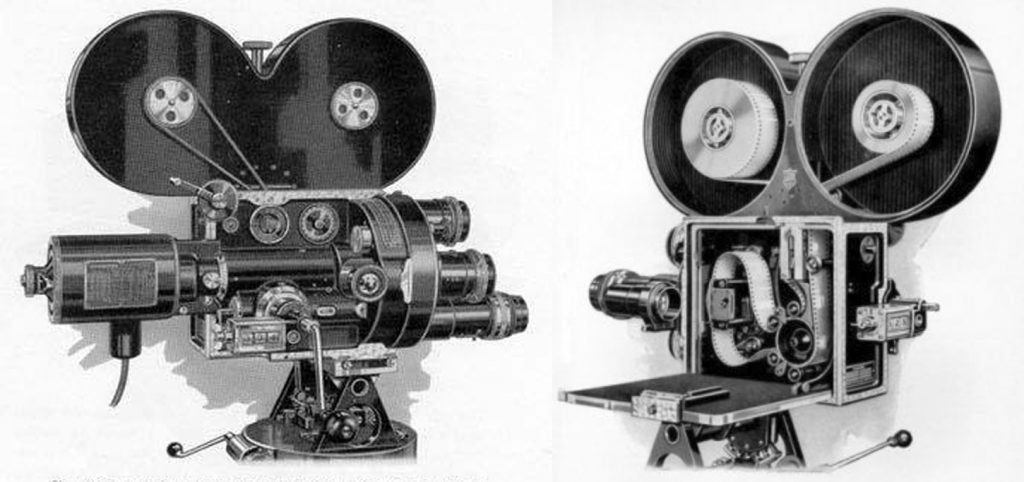Four Cameras That Changed The Film Industry
All you have to say is, ‘point-and-shoot’ and people will automatically think of a camera. It’s funny how these are the words we associate with cameras when they’re so much more complicated than this simple phrase lets on. It is true in one respect, however. Having the right camera is half the battle. The lens through which you look is the same lens through which your film will be viewed. That’s a very powerful thing and, on more than one occasion, the camera itself has been responsible for reshaping the entire film industry.
1) Bell & Howell 2709 Standard 35MM

Today when theaters receive new films, they are all in a standardized format so they can be played in any theater around the world. You never hear about a company having to order a new version of Infinity Wars because this one was the wrong film size, right? Well, that’s all thanks to Bell & Howell. When movie theaters first began opening, there wasn’t a universal film size that could be played at any theater. Obviously this caused some issues and Bell & Howell, a popular film equipment company at the time, began to solely manufacture their various projection and camera technology according to a 35mm film width format. This led to a standardization across the entire motion picture industry.
Not only that, but this camera was also significant because it was the first camera ever made of all metal. Prior to this model, cameras were built of wood and leather. The combination of the two innovations added to the company’s growing popularity and, by 1919, almost all productions throughout Hollywood were using Bell & Howell.
2) Bolex H16

The Bolex H16 was particularly impactful for independent filmmakers. Though the 35mm standardization of film was beneficial in many ways, it also led to filmmaking becoming an extremely expensive medium. During the 1930’s, there was really no option for aspiring filmmakers that wanted to try their hand at filmmaking. They simply had to be rich or they couldn’t make their movie.
Enter late 1930’s/ early 1940’s, and in comes the Bolex H16 camera. The Bolex H16 could produce quality images that rivaled that of expensive cameras, but at an affordable price. Though the camera’s 16mm film didn’t quite match up to the more expensive 35mm models, it rivaled it enough that it became the camera of choice for independent filmmakers for decades to come. According to IndieWire, it was even used by some of the most iconic filmmakers of all time, including Steven Spielberg and Darren Aronofsky.
3) RED ONE
It’s difficult to imagine nowadays since digital film is the norm, but there was a time when digital was considered taboo and lacking the quality of real film. The first camera that attempted to bridge the gap between digital and film cameras was the Sony HDW-F900, but unfortunately it mainly highlighted the faults with digital film rather than the benefits. While it showed that digital was a viable option, it still severely lacked the quality that film offered.
It wasn’t until the introduction of the RED ONE in 1999 that we saw digital film really take off. This was the first ever 4K-capable camera, which also had high frame rates and impressive low-light performance. This camera began the digital film age which ended up, again, benefiting Indie filmmakers because these were much more affordable.
4) IMAX
Believe it or not, the IMAX experience actually originated back in the early 1970’s with a showing of the movie Tiger Child in Osaka, Japan. This camera creates a film size three times larger than the standard 70mm. According to Premium Beat, “IMAX is roughly the digital equivalent of a 12K image.” When they were originally made, however, there were limitations. The size of the film stock significantly limited the run time so they were mostly used for documentaries.
Thankfully technology has progressed and we are now seeing IMAX popping up all over the place. Films like Dunkirk, Star Wars: The Force Awakens, and The Dark Knight Rises were all filmed in part using IMAX cameras. Avengers: Infinity War, holds a record as the first full-length feature shot entirely using an IMAX camera.
Though this camera will produce the most high-quality image out there, it definitely comes with some challenges. It is much bulkier and heavier than your average camera, so filmmakers have to get creative when trying to film action or POV shots. The filmmakers who worked on the Oscar-winning film Dunkirk had to come up with various rigs to be able to achieve aerial shots and shots from the cockpit. They also had to come up with creative ways for the ground POV shots to appear more like a handheld camera.
The camera itself is half the battle when it comes to filmmaking. Just as a filmmaker needs a good camera to make a quality film, the history of filmmaking itself has been equally shaped by both its filmmakers and the tools that they’ve used. The phrase ‘point-and-shoot’ should remain confined to the specific kind of camera, rather than being associated with the whole of film itself. Filmmakers do more than point and cameras can now do much more than just shoot.